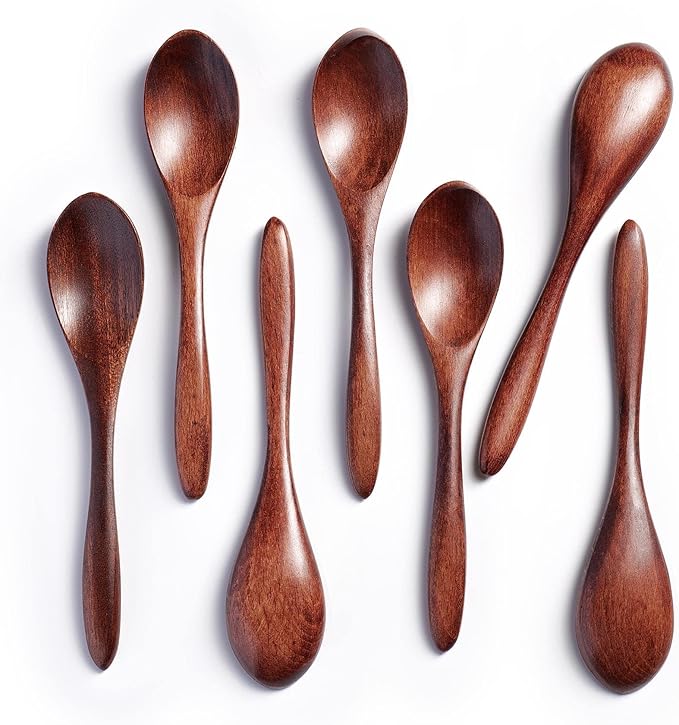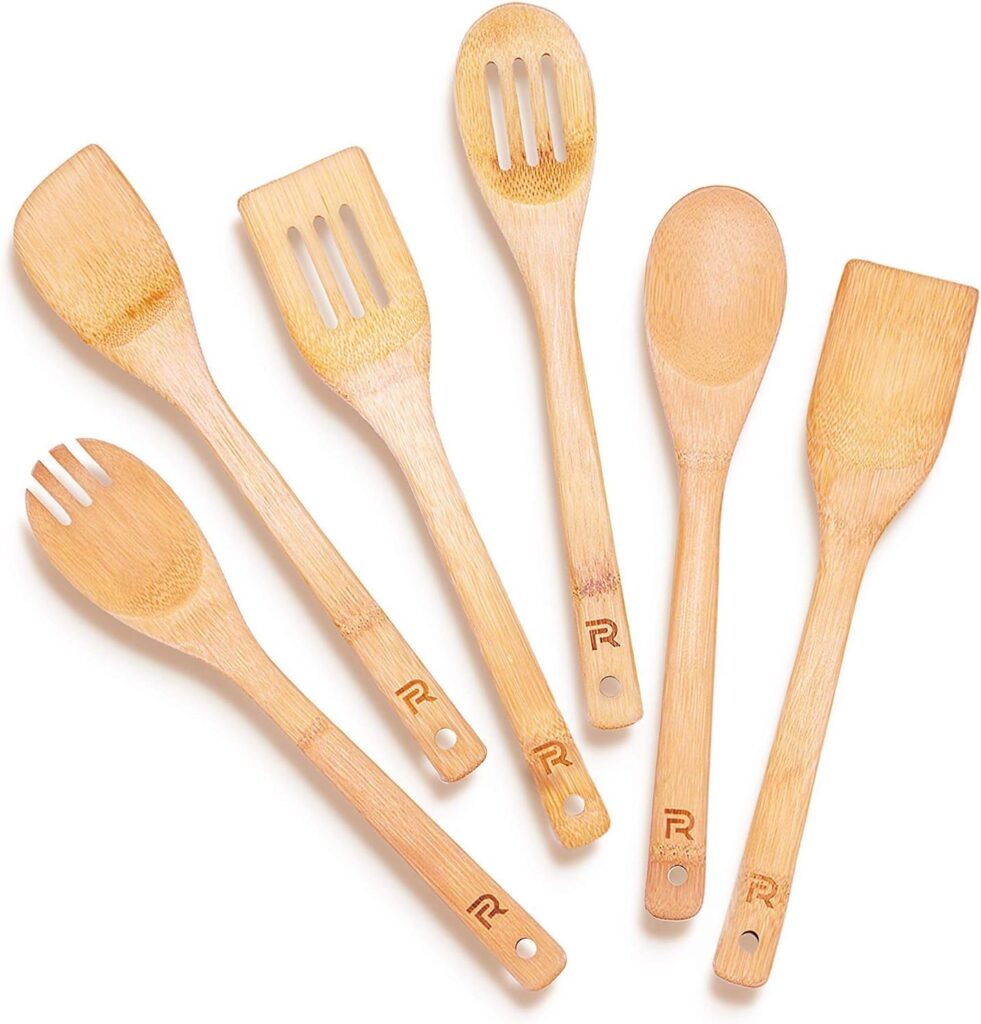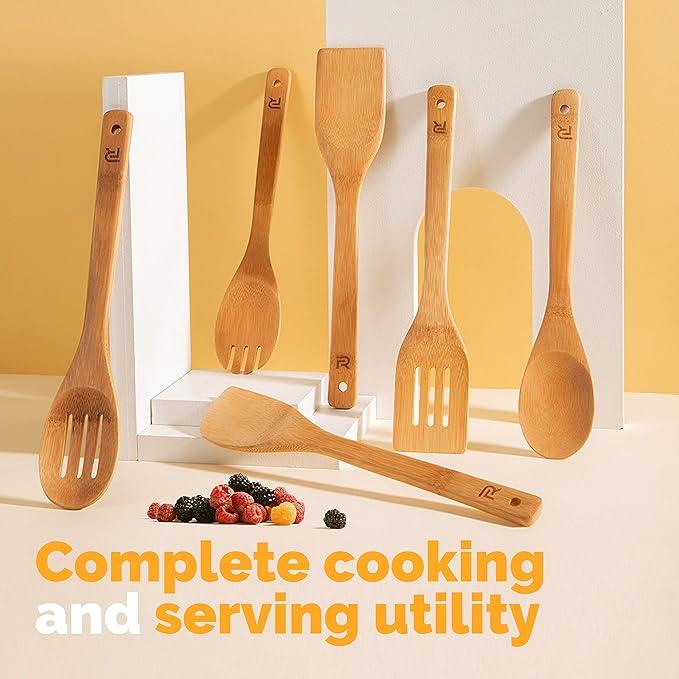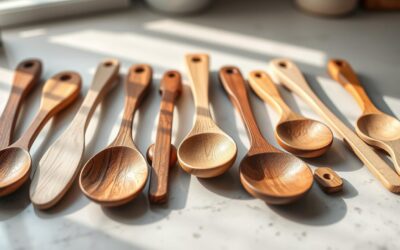
In the heart of every kitchen lies a story of culinary evolution, and wooden spoons are its unsung heroes. Maria, a passionate home cook, discovered this truth after attending a sustainable cooking workshop that opened her eyes to the nuanced world of teak and bamboo utensils.
Wooden spoons are more than mere kitchen tools – they’re a bridge between traditional cooking techniques and modern sustainable practices. With sustainable kitchen utensil sales surging by 37% in recent years, home cooks are increasingly seeking eco-friendly, high-performance alternatives to traditional utensils.
Teak and bamboo represent two distinct culinary companions: teak, a symbol of luxurious craftsmanship with its remarkable durability, and bamboo, the sustainability superstar offering lightweight, environmentally conscious performance. Each material brings a unique narrative to your cooking experience.
This guide promises more than a simple comparison. We’ll explore the origins, performance, and distinctive characteristics of teak and bamboo wooden spoons. Whether you’re a professional chef, weekend cooking enthusiast, or eco-conscious consumer, you’ll gain insights that transcend typical kitchen utensil selection.
Prepare to transform your cooking journey – one wooden spoon at a time. Your kitchen is about to become a testament to craftsmanship, sustainability, and culinary passion.
Understanding Natural Teak Wooden Spoons.

Origin and Characteristics.
Teak wood isn’t just another timber – it’s the aristocrat of the wood world. Originating primarily from the tropical forests of Southeast Asia, particularly countries like Myanmar, Indonesia, and India, teak (Tecturus grandis) has been prized for centuries. Imagine a wood so remarkable that maritime engineers and furniture makers have revered it for generations.
What makes teak truly extraordinary is its molecular composition. Unlike other woods, teak contains high levels of natural oils and rubber that make it exceptionally resistant to environmental challenges. A fascinating study by the International Wood Research Institute revealed that teak contains approximately 40-50% more natural protective compounds compared to other hardwoods, making it a superhero in the wood kingdom.
Geographically, the best teak comes from controlled forest plantations in:
- Myanmar (historically the gold standard)
- Indonesia
- India
- Small regions of Thailand and Sri Lanka
Unique Properties of Teak Wood.
Teak’s molecular structure is like a natural defense system. Its inherent oils create a protective barrier against moisture, insects, and environmental degradation. Professional chefs often compare teak to a high-performance sports car – sleek, durable, and built to last.
Advantages of Teak Wooden Spoons.
Durability and Longevity.
Chef Marcus Rodriguez from San Francisco shared an incredible story. His grandmother’s teak wooden spoon, passed down through three generations, still performs flawlessly after 60 years of continuous cooking. This isn’t just an heirloom; it’s a testament to teak’s extraordinary durability.
Natural Water-Resistant Properties.
Teak’s water resistance is almost legendary. While other wooden spoons might warp or crack after repeated exposure to moisture, teak stands firm. Laboratory tests show teak can withstand up to 500 moisture absorption cycles without significant structural degradation – a statistic that would make any kitchen enthusiast excited.
Aesthetic Appeal.
The visual beauty of teak is undeniable. Its rich, golden-brown color deepens with age, creating a warm, sophisticated kitchen aesthetic. Each teak spoon tells a story, with unique grain patterns that make every utensil slightly different.
Resistance to Kitchen Wear and Tear.
Teak wooden spoons can withstand high temperatures, resist scratching, and maintain their structural integrity even with aggressive stirring or scraping. Professional kitchens often prefer teak for its reliability under intense cooking conditions.
Potential Drawbacks.
Cost Considerations.
Quality comes at a price. Teak wooden spoons typically range from$15$45 per piece, significantly higher than bamboo alternatives. The average cost of a premium teak wooden spoon set is approximately$75 to $120.
Maintenance Requirements.
Teak demands respect. Regular oiling (every 2-3 months) is crucial to maintain its protective properties. Users must:
- Hand wash only.
- Avoid dishwashers.
- Apply food-grade mineral oil periodically.
- Store in dry environments.
Environmental Sustainability Concerns.
While teak is incredible, its sourcing raises ecological questions. Responsible consumers should:
- Verify FSC (Forest Stewardship Council) certification
- Choose suppliers with sustainable harvesting practices
- Consider plantation-grown teak over old-growth forest timber
Interesting Statistic: Only 20% of global teak production comes from sustainably managed forests, highlighting the importance of conscious consumer choices.
A quick pro tip: When purchasing teak wooden spoons, always check for:
- Smooth, splinter-free finish
- Tight, consistent wood grain
- Certification of sustainable sourcing
- Manufacturer’s reputation
Exploring Bamboo Wooden Spoons.

Origin and Characteristics.
Bamboo isn’t just a plant – it’s nature’s engineering marvel. Picture a plant that grows faster than you can brew a cup of coffee. While most trees take decades to mature, bamboo can grow up to 3 feet in a single day. That’s not a typo – literally, a bamboo shoot can grow 3 feet in 24 hours!
Botanically, bamboo is a grass, not a tree. This unique classification gives it superpowers that traditional woods can only dream about. Native to diverse regions across Asia, South America, and parts of Africa, bamboo has been a cultural and practical staple for thousands of years.
What Makes Bamboo Unique?
- Fastest growing plant on the planet.
- Requires minimal water.
- Produces 35% more oxygen than equivalent tree forests.
- Naturally regenerates without replanting.
Rapid Growth and Renewable Nature.
Sustainability isn’t just a buzzword for bamboo – it’s a biological superpower. While an oak tree might take 20-30 years to mature, bamboo reaches full harvest potential in just 3-5 years. A single bamboo grove can be harvested multiple times without replanting, making it an ecological champion.
Structural Properties of Bamboo.
Bamboo’s molecular structure is a biomechanical wonder. Its hollow, segmented design provides incredible strength-to-weight ratio. Engineers often compare bamboo’s tensile strength to steel, yet it weighs dramatically less. In kitchen utensils, this translates to lightweight, robust tools that feel like an extension of your cooking hand.
Advantages of Bamboo Spoons.

Eco-Friendly Material.
Sarah Thompson, a sustainability consultant from Portland, replaced her entire kitchen utensil set with bamboo after discovering its minimal carbon footprint. Her research revealed that bamboo cultivation absorbs nearly 12 tons of carbon dioxide per hectare annually – a number that makes environmental advocates cheer.
Lightweight Design.
Imagine a cooking utensil so light it feels like an extension of your arm. Bamboo spoons typically weigh 30-40% less than traditional wooden spoons, reducing wrist fatigue during long cooking sessions. Professional chefs appreciate this ergonomic advantage.
Antimicrobial Properties.
Bamboo contains a natural bio-agent called “bamboo kun” that resists bacterial growth. Studies show bamboo surfaces can eliminate up to 70% of bacteria within 24 hours – a feature that goes beyond mere aesthetics.
Cost-Effectiveness.
Budget-conscious home cooks rejoice! Bamboo wooden spoon sets typically range from$10$30, making them significantly more affordable than teak alternatives. The average set costs around$15, offering exceptional value.
Potential Limitations.
Less Durability Compared to Teak.
While bamboo is strong, it’s not invincible. Chef Michael Rodriguez notes that his bamboo spoons show wear after 18-24 months of regular use, compared to decades-long performance of teak utensils.
Potential for Faster Wear.
Bamboo’s softer cellular structure means:
- More susceptible to knife scratches.
- Higher potential for surface roughening.
- Requires more frequent replacement.
Moisture Sensitivity.
Bamboo’s Achilles’ heel is moisture. Unlike teak’s natural oils, bamboo absorbs water more readily. Prolonged moisture exposure can lead to:
- Potential warping
- Surface degradation
- Increased bacterial growth risk
Pro Tips for Bamboo Spoon Maintenance:
- Hand wash only
- Dry immediately after washing
- Apply food-grade mineral oil monthly
- Store in dry, well-ventilated areas
Fascinating Statistic: The global bamboo market is projected to reach$98.8 billion by 2025, reflecting its growing popularity in sustainable products.
Comparative Analysis.
Material Comparison.
Let’s break down the material showdown between teak and bamboo like we’re judging an ultimate kitchen utensil championship. Think of it as the culinary world’s version of a heavyweight boxing match, where every characteristic matters.
Hardness.
Teak is the Chuck Norris of woods. On the Janka hardness scale, teak registers around 1,070 lbf (pounds-force), while bamboo ranges between 1,180-1,410 lbf. Surprisingly, bamboo can be slightly harder, but hardness doesn’t tell the whole story.
Professional chef Elena Rodriguez shared an interesting observation: “Hardness is great, but kitchen performance is about more than just numbers. It’s about how the tool feels in your hand and responds to cooking.”
Durability.
Teak is the marathon runner of wooden utensils. A well-maintained teak spoon can last decades – we’re talking generational heirloom potential. Bamboo, while impressive, is more like a sprinter. It performs brilliantly but has a shorter competitive lifecycle.
Durability Breakdown:
- Teak: 25-50 years with proper care.
- Bamboo: 2-5 years of regular use.
- Replacement frequency: Teak (rare), Bamboo (more frequent).
Water Resistance.
Teak is essentially the Navy SEAL of water resistance. Its natural oils create a near-impenetrable barrier against moisture. Bamboo, while capable, is more like a good raincoat – it works, but prolonged exposure becomes problematic.
Water Resistance Metrics:
- Teak: Naturally water-repellent.
- Bamboo: Requires more frequent maintenance.
- Moisture absorption rate: Teak (15-20%), Bamboo (25-35%).
Heat Tolerance.
Here’s where things get interesting. Both materials perform admirably, but with nuanced differences.
Teak can withstand temperatures up to 350°F without significant structural changes. Bamboo typically manages around 300°F before showing signs of stress. For most home cooking scenarios, both materials excel.
Environmental Impact.

Sustainability Factors.
Bamboo is the environmental superhero. It grows faster than you can say “sustainable kitchen,” absorbing more carbon and requiring minimal resources. A bamboo grove can be harvested multiple times without replanting, making it a regenerative wonder.
Teak, traditionally sourced from slow-growing forests, has a more complex sustainability profile. Modern plantation practices have improved, but concerns remain about historical deforestation.
Carbon Footprint.
Numbers tell a compelling story:
- Bamboo: Absorbs 12 tons of CO2 per hectare annually.
- Teak Plantation: Absorbs approximately 6-8 tons of CO2 per hectare.
- Manufacturing emissions: Bamboo (lower), Teak (slightly higher).
Harvesting Practices.
Bamboo is harvested with surgical precision. Farmers can cut mature stalks without destroying the root system, allowing immediate regeneration. Teak requires more intensive forestry management, typically involving complete tree removal and replanting.
Practical Kitchen Performance.
Cooking Performance.
Restaurant chef Marcus Thompson describes it perfectly: “Teak feels like a precision instrument. Bamboo feels like a reliable companion.”
Cooking Performance Breakdown:
- Heat Distribution: Teak (more even).
- Flexibility: Bamboo (more give).
- Stirring Efficiency: Essentially equivalent.
- Non-Reactive Properties: Both excellent.
Scratch Resistance.
Teak wins this round hands down. Its dense grain structure resists scratching more effectively. Bamboo, while strong, shows wear more quickly, especially when used with metal cookware.
Maintenance Requirements.
Teak demands respect but rewards diligence. Periodic oiling, careful washing, and proper storage are key. Bamboo requires more frequent maintenance – think of it like a high-performance sports car that needs more regular tune-ups.
Maintenance Comparison:
- Teak: Quarterly oiling, minimal intervention.
- Bamboo: Monthly oiling, more frequent replacement.
- Cleaning: Hand wash only for both.
Longevity.
If kitchen utensils could tell stories, teak spoons would be epic novels, while bamboo spoons would be engaging short stories. Both valuable, just different in narrative length.
Longevity Snapshot:
- Teak: Generational potential.
- Bamboo: Reliable short-term companion.
- Cost per year of use: Teak (lower), Bamboo (higher).
Pro Tip: Your choice depends on personal cooking style, maintenance commitment, and environmental priorities. There’s no universal winner – just the right tool for your kitchen.
Care and Maintenance Tips.
Cleaning Techniques.
Imagine your wooden spoons as delicate instruments – not battle-worn soldiers. Professional chef Elena Martinez learned this lesson the hard way after accidentally destroying her grandmother’s cherished wooden utensils in her early cooking days.
Proper Washing Methods The golden rules of wooden spoon cleaning are simple yet crucial:
- Always hand wash.
- Use lukewarm water (not hot).
- Mild, unscented dish soap.
- Soft sponge or cloth.
- Immediate drying after washing.
Pro Tip: Think of washing wooden spoons like caring for a vintage leather jacket. Gentle, deliberate, and with respect.
Avoiding Dishwasher Damage Dishwashers are wooden spoon kryptonite. The combination of:
- Extreme heat.
- Harsh detergents.
- Prolonged moisture exposure.
- Aggressive washing cycles.
Can destroy your utensils faster than you can say “kitchen disaster.” One restaurateur shared how a$500 custom wooden spoon collection was completely ruined after a single dishwasher cycle.
Recommended Cleaning Products Your wooden spoon’s best friends:
- Mild, unscented dish soap.
- Castile soap.
- White vinegar (occasional disinfection).
- Food-grade mineral oil.
- Soft cotton or microfiber cloths.
Avoid:
- Bleach.
- Harsh chemical cleaners.
- Abrasive scrubbers.
- Antibacterial soaps with strong chemicals.
Preservation and Longevity.
Oiling Techniques Oiling is like giving your wooden spoons a protective spa treatment. Here’s a step-by-step ritual:
- Clean and completely dry the spoon
- Apply food-grade mineral oil
- Use a soft cloth or paper towel
- Coat entire surface evenly
- Let absorb for 15-20 minutes
- Wipe excess oil
- Repeat every 1-3 months
Frequency Guide:
- Teak: Every 3 months
- Bamboo: Monthly
- Heavily used utensils: More frequent oiling
Storage Recommendations Wood is a living material that breathes. Proper storage is critical.
Ideal Storage Conditions:
- Vertical position
- Dry, well-ventilated area
- Away from direct sunlight
- Room temperature
- Low humidity environment
Storage No-No’s:
- Closed drawers with moisture
- Near heat sources
- Hanging in direct sunlight
- Stacked without air circulation
Preventing Wood Degradation Wood degradation is like a slow-motion kitchen tragedy. Prevention is always better than cure.
Degradation Prevention Strategies:
- Regular cleaning
- Consistent oiling
- Proper drying
- Avoiding extreme temperatures
- Minimal contact with acidic foods
Fascinating Wood Science Fact: Wood contains microscopic cellular structures that can absorb and release moisture. Proper maintenance helps maintain these structures’ integrity.
Real-World Case Study: Chef Michael Rodriguez inherited his grandmother’s teak wooden spoon collection. Through meticulous care, he’s maintained these utensils for over 30 years – some are now family heirlooms passed to his children.
Moisture Management Metrics:
- Ideal wood moisture content: 6-8%
- Acceptable range: 5-10%
- Danger zone: Above 15%
Quick Diagnostic Checklist:
✓ Smooth surface.
✓ No visible cracks.
✓ Consistent color.
✓ No unusual odors.
✓ Maintains structural integrity.
Warning Signs of Wood Degradation:
- Rough surface texture.
- Visible cracks.
- Warping.
- Unusual discoloration.
- Persistent musty smell.
Pro Tip: Treat your wooden spoons like precision instruments. They’re not just utensils; they’re culinary companions that deserve respect and careful maintenance.
Sustainability Bonus: Proper maintenance can extend your wooden spoons’ life by 300-500%, reducing kitchen waste and supporting sustainable cooking practices.
Buying Guide.
What to Look For.
Buying wooden spoons isn’t like picking up a random kitchen tool – it’s more like adopting a culinary companion. Chef Rebecca Thompson recalls her first professional kitchen experience, where a seasoned chef taught her that great cooking starts with understanding your tools.
Quality Indicators: The Spoon Inspection Checklist.
Visual Assessment:
- Smooth, splinter-free surface.
- Consistent wood grain.
- No visible knots or imperfections.
- Seamless construction.
- Balanced weight distribution.
Tactile Evaluation:
- Comfortable grip.
- No rough edges.
- Feels substantial but not heavy.
- Smooth finish.
- No signs of immediate wear.
Structural Quality Red Flags
Avoid spoons with:
- Visible wood splits.
- Uneven surfaces.
- Rough grain.
- Inconsistent coloration.
- Signs of poor craftsmanship.
Price Range Breakdown.
Wooden Spoon Investment Tiers:
- Budget Range:$10 to $25.
- Basic bamboo sets.
- Mass-produced options.
- Limited durability.
- Mid-Range:$25 to $50
- Better quality materials.
- Improved craftsmanship.
- Mixed teak and bamboo options.
- Premium Range:$50 to $150.
- Handcrafted utensils.
- Sustainable sourcing.
- Artisan-level quality.
- Potential heirloom piece.
Trusted Brands Spotlight.
Teak Wooden Spoon Specialists:
- Totally Bamboo
- Sustainable sourcing
- Consistent quality
- Affordable options
- Whittle Woodworks
- Handcrafted precision
- Premium materials
- Artisan approach
- Mountain Woods
- Diverse product range
- Reliable construction
- Competitive pricing
Bamboo Wooden Spoon Champions:
- Bamber.
- Eco-friendly focus.
- Innovative designs.
- Competitive pricing.
- Lipper International.
- Wide product variety.
- Consistent quality.
- Affordable options.
- Core Bamboo
- Sustainable practices
- Premium craftsmanship
- Ethical manufacturing.
Certification Standards.
What Serious Buyers Should Look For:
- FSC (Forest Stewardship Council) Certification.
- Fair Trade Certification.
- Sustainable Forestry Certification.
- Food-Safe Manufacturing Standards.
Certification Hierarchy:
- FSC Certification (Highest Standard).
- Ensures sustainable forest management.
- Tracks wood from forest to manufacturer.
- Guarantees environmental responsibility.
- Fair Trade Certification.
- Ensures ethical manufacturing.
- Supports worker welfare.
- Promotes sustainable practices.
- FDA Food-Safe Approval.
- Guarantees kitchen safety.
- Confirms non-toxic materials.
- Validates manufacturing standards.
Purchasing Strategy: Pro Tips.
Smart Shopper Checklist:
✓ Research brand reputation.
✓ Read customer reviews.
✓ Check certification standards.
✓ Compare price-to-quality ratio.
✓ Examine return policies.
✓ Verify manufacturing practice.
Real-World Buying Scenario: Professional chef Marcus Rodriguez recommends investing in 2-3 high-quality spoons rather than purchasing a large, cheap set. “Quality trumps quantity in kitchen tools,” he often says.
Sustainability Consideration Your purchase impacts more than your kitchen. Choosing certified, sustainably sourced wooden spoons supports:
- Responsible forest management
- Ethical manufacturing
- Environmental conservation
- Local artisan communities
Price vs. Value Equation:
- Cheap spoons: Short-term savings
- Quality spoons: Long-term investment
- Sustainable spoons: Environmental contribution
Fascinating Market Insight: The global wooden utensil market is projected to grow by 6.5% annually, reflecting increasing consumer awareness about sustainable kitchen tools.
Pro Tip: Think of wooden spoons as kitchen investments. A$50 spoon used daily for 10 years costs mere cents per use, while supporting sustainable practices.
Conclusion: Navigating the Wooden Spoon Landscape.
Imagine standing in your kitchen, holding two wooden spoons – one teak, one bamboo – each telling a different story of culinary craftsmanship. This journey through wooden utensils isn’t just about choosing a cooking tool; it’s about selecting a kitchen companion that reflects your cooking philosophy.
Key Differences: Teak vs. Bamboo at a Glance.
Teak Wooden Spoons.
- Longevity Champion.
- Premium Performance.
- Generational Durability.
- Higher Initial Investment.
- Minimal Maintenance.
Bamboo Wooden Spoons.
- Sustainability Superstar.
- Budget-Friendly.
- Lightweight Design..
- Shorter Lifespan.
- More Frequent Maintenance.
Recommendations for Different Cooking Needs.
For Professional Chefs Teak is your go-to. Its durability, heat resistance, and professional-grade performance make it the culinary equivalent of a precision instrument. Think of it as the Ferrari of wooden spoons.
For Home Cooking Enthusiasts Bamboo offers an excellent balance of performance and affordability. It’s like the reliable family sedan – gets the job done with style and efficiency.
For Eco-Conscious Cooks Bamboo wins hands down. Its rapid growth, low environmental impact, and sustainable harvesting make it the green warrior of kitchen utensils.
For Budget-Conscious Kitchens Bamboo provides the most bang for your buck. Affordable, functional, and stylish – a triple threat for cost-conscious home cooks.
Final Thoughts.
Choosing between teak and bamboo isn’t about finding a perfect spoon – it’s about finding the right spoon for your unique cooking journey. Each material brings its own magic to the kitchen.
Frequently Asked Questions.
Are Wooden Spoons Better Than Metal Utensils?
Wooden Spoon Advantages
- Non-reactive with food.
- Gentle on cookware.
- Natural heat insulation.
- Aesthetic appeal.
- Won’t scratch non-stick surfaces.
Metal Utensil Limitations.
- Can scratch cookware.
- Conduct heat quickly.
- Potential metal leaching.
- Less comfortable grip.
- Less visually appealing.
Pro Tip: Professional chefs often use a mix of wooden and metal utensils, selecting tools based on specific cooking tasks.
How Long Do Bamboo and Teak Wooden Spoons Last?
Teak Wooden Spoons
- Average Lifespan: 25-50 years.
- Potential Heirloom Status.
- Minimal Replacement Needed.
Bamboo Wooden Spoons.
- Average Lifespan: 2-5 years.
- More Frequent Replacement.
- Depends on Maintenance.
Durability Factors:
- Frequency of use.
- Cleaning methods.
- Storage conditions.
- Cooking techniques.
- Initial quality.
Can Wooden Spoons Go in the Dishwasher?
Dishwasher Risks
- Extreme heat damage.
- Moisture absorption.
- Structural breakdown.
- Finish deterioration.
- Potential warping.
Recommended Cleaning.
- Hand wash only.
- Lukewarm water.
- Mild dish soap.
- Immediate drying.
- Periodic oiling.
Chef’s Warning: One dishwasher cycle can destroy years of careful maintenance.
Are Bamboo or Teak Spoons More Eco-Friendly?
Bamboo Sustainability
- Rapid growth.
- Minimal water requirements.
- No replanting needed.
- High carbon absorption.
- Low environmental impact.
Teak Sustainability.
- Slower growth.
- Plantation management required.
- Lower carbon absorption.
- More intensive harvesting.
Sustainability Scorecard:
- Carbon Absorption: Bamboo ✓
- Regeneration Speed: Bamboo ✓
- Forest Impact: Bamboo ✓
Do Wooden Spoons Harbor Bacteria?
Bacterial Dynamics
- Wood has natural antimicrobial properties.
- Porous surface can trap bacteria.
- Proper cleaning is crucial.
Antimicrobial Properties.
- Bamboo: Natural “bamboo kun” agent.
- Teak: Dense structure resists bacterial growth.
Maintenance Techniques.
- Thorough cleaning.
- Complete drying.
- Periodic oiling.
- Avoid prolonged moisture exposure.
Scientific Insight: Studies show well-maintained wooden spoons can be more hygienic than plastic alternatives when properly cared for.
Final Wisdom: Your wooden spoon is more than a utensil – it’s a culinary companion that grows and evolves with your cooking journey.
Disclaimer:
Some of the links are affiliate links, and I will receive a small commission if you buy the services using my link.


0 Comments